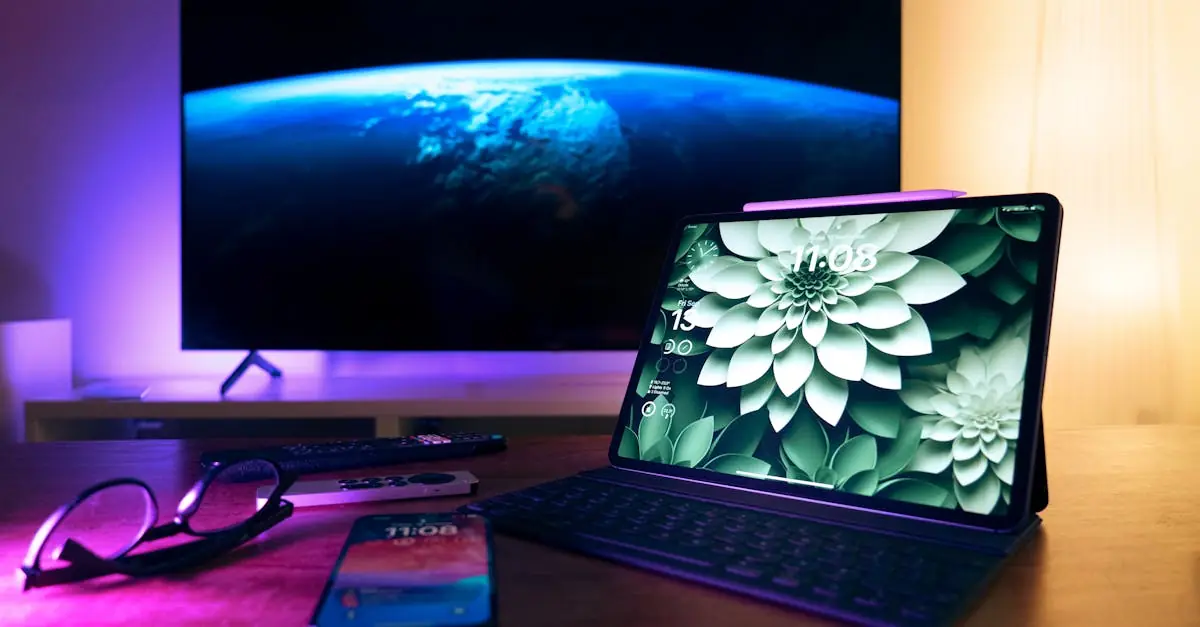Table of Contents
ToggleImagine lounging on your couch, scrolling through your favorite photos or binge-watching the latest series on your iPhone, only to realize the screen feels a bit too small. What if there was a way to turn that tiny display into a cinematic masterpiece? Well, it’s time to unleash the full potential of your iPhone by mirroring it to your smart TV.
Understanding Screen Mirroring
Screen mirroring enables users to display their iPhone screen on a smart TV. This technology allows for seamless sharing of content, making it ideal for various activities.
What Is Screen Mirroring?
Screen mirroring refers to the process of duplicating the content of a device onto another display. iPhones utilize AirPlay, Apple’s proprietary technology, for this purpose. Users can share videos, images, and presentations in real-time. Compatibility with smart TVs and streaming devices enhances the experience. Viewing content on a larger screen becomes convenient, creating a more immersive atmosphere for entertainment.
Benefits of Mirroring Your iPhone
Mirroring an iPhone offers several advantages. First, it enhances visual engagement; photos and videos appear significantly larger. Second, multiple viewers can see the content at once, improving social interactions during gatherings. Third, playing games or using apps on a larger screen amplifies the overall experience. Furthermore, presenting slideshows or important documents during meetings becomes easier. Last, the mirroring process streamlines access to various streaming services, allowing users to enjoy their favorite shows effortlessly.
Preparing Your Devices
Preparing devices for screen mirroring involves a few simple steps.
Checking Compatibility
Confirming compatibility between the iPhone and smart TV is essential. Most modern smart TVs, such as those from Samsung, LG, and Sony, support AirPlay. Check manufacturer specifications to ensure that the TV model allows for screen mirroring. Additionally, ensure the iPhone is running iOS 12 or later for optimal functionality. Some third-party streaming devices, including Apple TV, can also facilitate the mirroring process. Performing a quick search on the model numbers can save time and frustration.
Connecting to the Same Wi-Fi Network
Connecting both devices to the same Wi-Fi network is crucial for the mirroring process to work effectively. Most smart TVs allow you to access the network settings through the main menu. Find the Wi-Fi option and verify the connection. On the iPhone, go to Settings, then Wi-Fi, and connect to the same network. When both the iPhone and smart TV share the same connection, it enables seamless communication between the devices. Ensuring a stable and fast Wi-Fi connection enhances performance during mirroring sessions.
How to Mirror iPhone on Smart TV
Mirroring an iPhone to a smart TV greatly enhances viewing experiences. Users can utilize two primary methods: AirPlay and third-party apps.
Using AirPlay
AirPlay simplifies the mirroring process significantly. It allows users to wirelessly stream content from an iPhone to compatible smart TVs. First, access the Control Center by swiping down from the upper right corner of the iPhone screen. Tap on “Screen Mirroring,” and select the desired smart TV. Ensure the TV prompts for a code, if applicable. Enter the code to establish the connection. Once connected, the iPhone screen displays on the TV, providing the ideal platform for playing videos, sharing photos, and more.
Using Third-Party Apps
Third-party apps offer an alternative option for mirroring when AirPlay isn’t available. Several apps, like ApowerMirror and LetsView, facilitate screen sharing across non-AirPlay compatible devices. After downloading the preferred app on both the iPhone and smart TV, follow the app’s setup instructions. Generally, users must connect both devices to the same Wi-Fi network. Next, open the app on the iPhone and choose the smart TV from the list of available devices. Initiating the mirroring process typically involves pressing a dedicated button within the app, making it straightforward for users to enjoy content on a larger screen.
Troubleshooting Common Issues
Users may encounter issues while mirroring their iPhone to a smart TV. Understanding common problems helps ensure a smoother experience.
Connection Problems
Connection issues often arise between the iPhone and the smart TV. First, users should check if both devices are connected to the same Wi-Fi network. Verifying network settings is crucial. If connection fails, restarting both the iPhone and smart TV may resolve the issue. Sometimes, updates to the iOS or TV firmware improve compatibility. Disabling and re-enabling Wi-Fi can also help. Users should be aware that too many devices on the same network can affect performance as well, making it beneficial to limit connected devices during mirroring sessions.
Quality and Performance Issues
Quality and performance problems may disrupt the mirroring experience. Users might notice lag, distortion, or poor resolution during playback. Checking Wi-Fi connection strength is a great first step, as weak signals contribute to these issues. Keeping the iPhone close to the smart TV generally improves connectivity. If users face consistent issues, reducing the number of running applications on the iPhone can free up resources. Additionally, ensuring that both devices have the latest software updates can improve mirroring performance significantly. Frequently, adjusting the video quality settings on streaming services can also enhance the viewing experience.
Mirroring an iPhone to a smart TV opens up a world of possibilities for users seeking a more immersive experience. Whether it’s sharing photos during gatherings or enjoying movies on a larger screen, the benefits are clear. With simple steps to connect via AirPlay or third-party apps, users can easily enhance their viewing pleasure.
By ensuring compatibility and maintaining a strong Wi-Fi connection, the mirroring process becomes seamless. Troubleshooting tips further empower users to tackle any issues that may arise. Embracing this technology not only enriches entertainment but also transforms how content is shared and enjoyed in the home.





